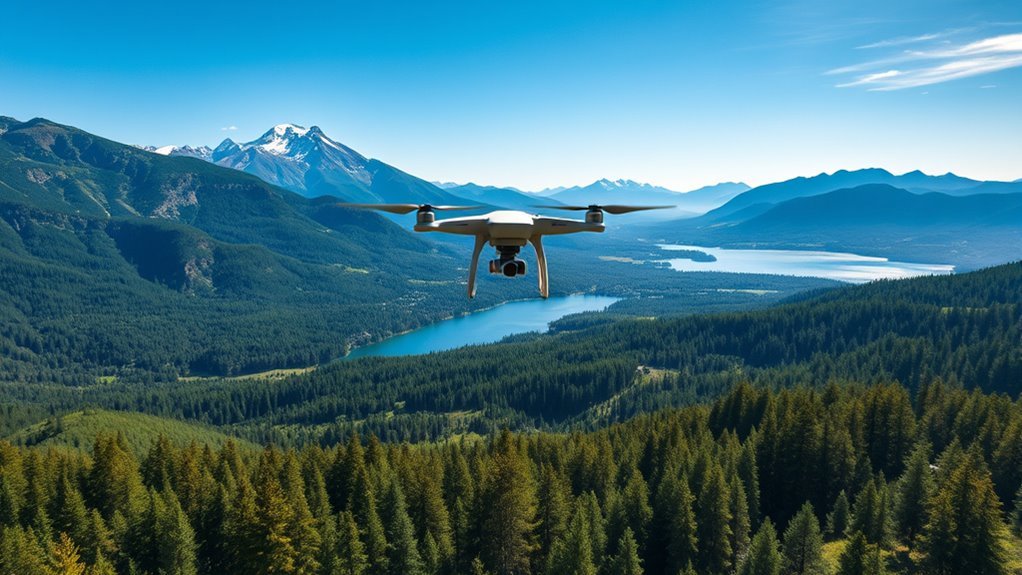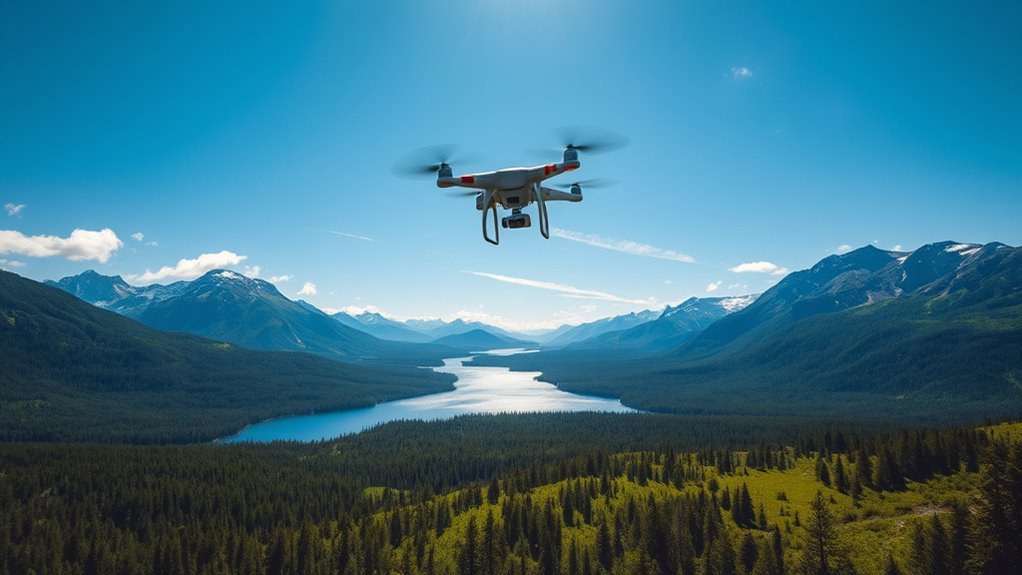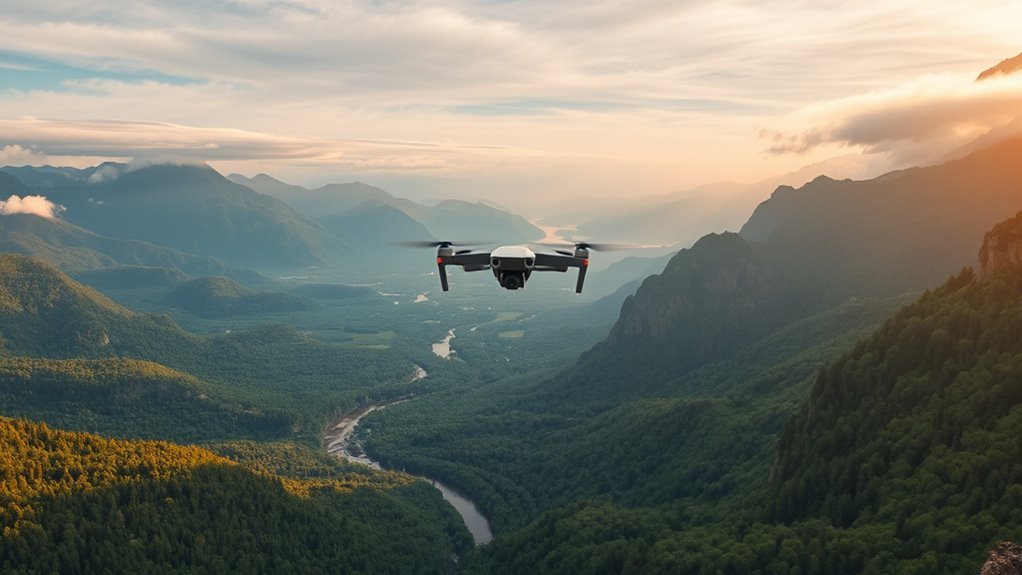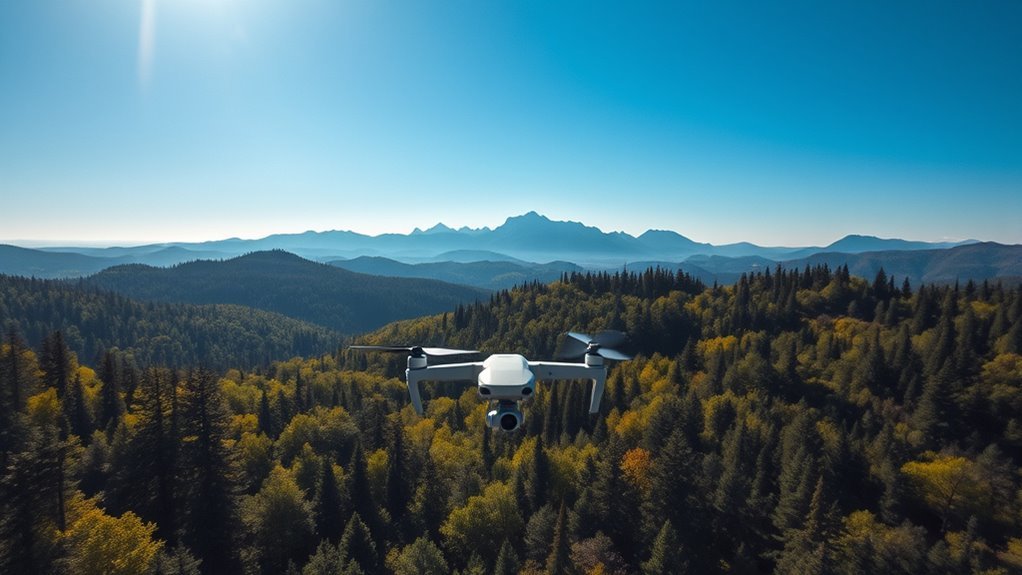To fly drones in national parks, you must understand strict regulations set by the National Park Service. Many parks have outright bans, while others require permits for designated areas. Violating these laws can lead to severe fines and drone confiscation. Always respect wildlife and minimize environmental impact. Plan your flight path and consider weather conditions carefully. Engaging with local communities can enhance your experience, and there’s more to learn about optimizing your drone operation and photography.
Understanding National Park Regulations

When considering flying drones in national parks, it’s crucial to understand the specific regulations that govern their use. The National Park Service (NPS) enforces strict national park policies regarding drone flying, and you need to comply with these to avoid fines or other penalties. Generally, you’ll require drone permits before taking off in most national parks. These permits guarantee that you respect wildlife, maintain the safety of other visitors, and adhere to park preservation efforts. It’s important to familiarize yourself with the specific rules of the park you plan to visit, as regulations can vary greatly. By understanding these regulations, you can enjoy the freedom of flying while also protecting these natural treasures for future generations.
Permitted Areas for Drone Flying

While many national parks prohibit drone flying, some areas may allow it under specific conditions. You’ll need to familiarize yourself with designated zones where drone use is permitted, guaranteeing you respect restricted locations. Each park has its own regulations, so check before you launch.
Here’s a quick reference table for common national parks and their drone policies:
| National Park | Drone Policy |
|---|---|
| Yellowstone National Park | No drones allowed |
| Grand Canyon National Park | Designated zones only |
| Zion National Park | Restricted but allowed |
| Yosemite National Park | No drones allowed |
| Glacier National Park | Designated zones only |
Adhering to these guidelines guarantees you can enjoy your freedom to fly while preserving the park’s natural beauty.
Legal Consequences of Violating Drone Laws

Failing to adhere to drone regulations in national parks can lead to serious legal repercussions. Ignoring these laws not only jeopardizes your freedom but can also have significant consequences. Here’s what you might face:
Ignoring drone regulations in national parks can result in hefty fines, equipment seizure, and even criminal charges. Stay compliant to protect your freedom.
- Fines and penalties: You could incur hefty fines, sometimes exceeding thousands of dollars.
- Seizure of equipment: Authorities may confiscate your drone, leaving you without your investment.
- Criminal charges: In severe cases, you could face criminal charges that may result in a permanent record.
- Park bans: Violating these laws can lead to restrictions on future visits to national parks.
Understanding these legal repercussions is vital for anyone looking to enjoy the freedom of flying drones in these protected areas. Stay informed and compliant to avoid costly mistakes.
Best Practices for Responsible Drone Use
Understanding the legal consequences of violating drone laws highlights the importance of responsible drone use in national parks. To guarantee a safe and enjoyable experience for everyone, adhere to drone etiquette. Always maintain a respectful distance from wildlife and other visitors, avoiding noise disturbances and potential hazards. Engage with the local community by informing them of your drone activities, fostering goodwill and cooperation. Before flying, check for any park-specific regulations and temporary restrictions. Limit your flight times to minimize disruption, and consider the views of fellow park-goers. By promoting community engagement and following these best practices, you not only protect the park’s natural beauty but also preserve the freedom to fly responsibly within these cherished spaces.
Environmental Impact of Drones in Natural Spaces
As you consider the use of drones in natural spaces, it is vital to recognize their potential environmental impacts. These devices can disturb wildlife, disrupt ecosystem balance, and contribute to noise pollution, all of which pose significant concerns for conservation efforts. Understanding these effects is important for ensuring responsible drone operation in sensitive habitats.
Wildlife Disturbance Concerns
While the allure of capturing stunning aerial views in national parks is undeniable, the potential for wildlife disturbance is a significant concern. Drone interactions can disrupt wildlife behavior in ways that threaten their well-being. It’s vital to be aware of these impacts, which include:
- Stress Responses: Animals may exhibit stress behaviors, affecting their health and breeding.
- Disruption of Feeding: Drones can interrupt feeding patterns, leading to reduced energy intake.
- Altered Movement: Wildlife might change their natural movement patterns to avoid drones.
- Increased Mortality Risks: Disturbances can lead to dangerous situations, such as increased vulnerability to predators.
Being mindful of these factors helps protect the delicate balance within national parks. Enjoy the freedom of flight, but respect wildlife’s need for peace.
Ecosystem Balance Disruption
Although drones offer unique perspectives in natural spaces, their operation can considerably disrupt ecosystem balance. When you fly a drone in these areas, you risk compromising ecosystem integrity, as the presence of your device can alter wildlife behaviors and habitats. Species may become stressed or disoriented, which can lead to population declines and disrupt food chains. Additionally, drones can trespass into sensitive areas, hindering habitat preservation efforts that are vital for maintaining biodiversity. It’s important to recognize that these disruptions can have long-term consequences, not just for individual species but for entire ecosystems. By adhering to regulations and respecting designated no-fly zones, you can help mitigate these impacts and guarantee that natural spaces remain vibrant and resilient.
Noise Pollution Effects
The operation of drones in national parks not only disrupts ecosystem balance but also contributes greatly to noise pollution. This noise disturbance can markedly affect both the environment and wildlife sensitivity. When flying drones, you should be aware of the following impacts:
- Increased stress levels in wildlife, leading to altered behaviors.
- Disruption of mating and nesting activities in sensitive species.
- Decreased visitor enjoyment, as natural sounds are drowned out.
- Potential long-term habitat degradation due to constant noise exposure.
Understanding these effects is vital for preserving the natural beauty and tranquility of national parks. By being mindful of your drone usage, you can help maintain the delicate balance of these cherished environments while enjoying your freedom to explore.
Tips for Capturing Great Aerial Footage
To capture exceptional aerial footage with your drone, it’s essential to plan your flight path carefully to guarantee you cover all desired angles. Adjusting your camera settings to match environmental conditions will enhance image quality considerably. Additionally, consider the time of day for ideal lighting, as this can dramatically affect the visual impact of your footage. Furthermore, understanding the no-fly zone regulations is crucial to ensure a legal and safe flying experience in protected areas like national parks.
Plan Your Flight Path
When planning your flight path for capturing stunning aerial footage in national parks, it’s essential to contemplate both the regulations and the natural landscapes you’ll be filming. To guarantee effective flight planning and route enhancement, follow these key steps:
- Research regulations: Familiarize yourself with specific park rules regarding drone usage.
- Identify key locations: Pinpoint areas of interest that showcase the park’s natural beauty.
- Map your route: Create a clear flight path that avoids restricted zones and maximizes visual appeal.
- Consider weather conditions: Check forecasts to select ideal flight times, guaranteeing safety and quality footage.
Use Proper Camera Settings
Achieving stunning aerial footage requires an understanding of your camera settings to optimize image quality and capture the park’s beauty effectively. Start by adjusting your camera resolution; higher settings yield clearer, more detailed images. However, keep in mind that this may affect your storage capacity. Next, pay close attention to your exposure settings. A properly exposed image balances highlights and shadows, ensuring vibrant colors and details in the landscape. Utilize the histogram feature to monitor exposure levels, avoiding overexposed or underexposed shots. Additionally, consider using manual mode to have full control over shutter speed, aperture, and ISO. Mastering these settings allows you to release your creativity while respecting the natural beauty of national parks, enhancing your aerial photography experience.
Consider Time of Day
Capturing breathtaking aerial footage hinges not only on your camera settings but also on the time of day you choose to fly. The quality of light can dramatically affect your visuals. Here are some tips to maximize your drone shots:
- Morning Light: Early hours provide soft, diffused light, enhancing colors and reducing harsh shadows.
- Golden Hour: The hour after sunrise and before sunset offers warm tones that can make your footage truly enchanting.
- Avoid Midday: Harsh sunlight creates unflattering contrasts and can wash out details in your shots.
- Sunset Shadows: Late afternoon casts long shadows, adding depth and drama to your footage.
Taking these factors into account will elevate your aerial photography experience in national parks.
Frequently Asked Questions
Can I Fly My Drone at Night in National Parks?
You might think night flying’s thrilling, but drone regulations prohibit it in national parks. Safety concerns and wildlife protection guide these rules, so you’ll need to fly during daylight to enjoy the freedom responsibly.
Do I Need a Special License to Fly a Drone?
You don’t need a special license to fly a drone, but you must comply with drone regulations. Obtaining pilot certification can enhance your skills and guarantee you fly responsibly, enjoying your freedom without legal issues.
Are There Age Restrictions for Drone Pilots in National Parks?
Imagine soaring like an eagle, but before you take flight, know there’re age requirements for drone pilots. Generally, you must be 13, though age exemptions exist for specific cases. Stay informed to fly responsibly.
How Do I Report a Drone Incident in a National Park?
If you witness a drone incident, report it to park authorities immediately. Guarantee you include details about drone safety concerns, the incident’s specifics, and your contact information for effective incident reporting and follow-up actions.
What Should I Do if I See Someone Flying a Drone Illegally?
If you see someone flying a drone illegally, document the drone violations, note the location, and report it to park authorities. Understanding park regulations guarantees everyone can enjoy the natural beauty without disruption.

